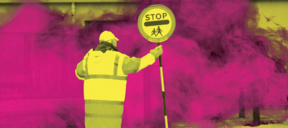Religious orders involved in redress sold properties totalling €90 million since 2016
Investigation by Noteworthy finds these congregations paid €27m to the State in redress during this time.
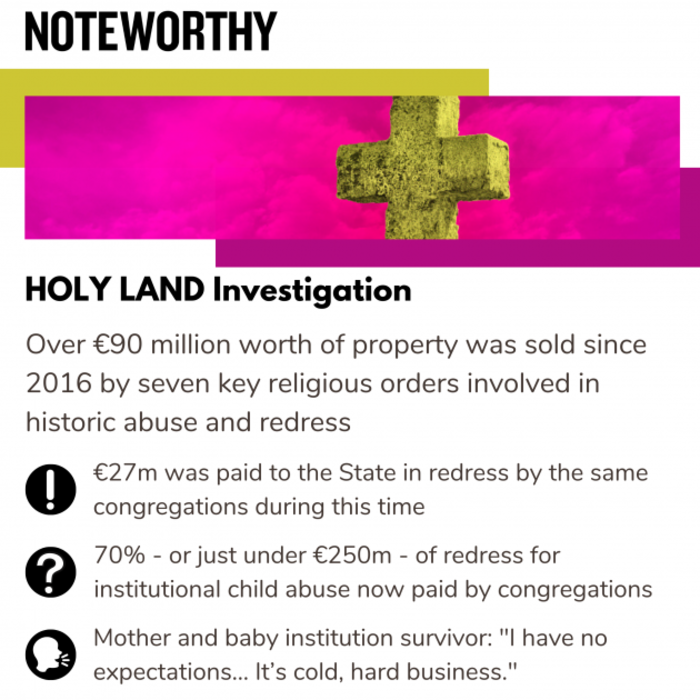
—
RELIGIOUS CONGREGATIONS INVOLVED in historic abuse have sold over 75 properties worth a total of over €90 million since 2016.
During this time, €27m was paid to the State in redress by the same seven key organisations analysed by Noteworthy.
Though most religious congregations have paid redress offered for institutional child abuse, there is still a shortfall of around €105m – according to our calculations from figures provided by the Department of Education (DoE) – with over 90% of this from the Sisters of Mercy who are in the middle of transferring two further properties.
In addition, four congregations – including the Sisters of Mercy – ran Magdalene laundries but “declined to make a financial contribution” towards the implementation of the Magdalene Laundries Restorative Justice Ex-Gratia Scheme, the Government reported at the time.
The Sisters of Mercy – alongside five others – is also currently in negotiations with Minister for Children Roderic O’Gorman in relation to the Mother and Baby Institutions Payment Scheme, the latest form of redress announced by the Government to address historic abuse.
We found that this congregation likely disposed of over 45 properties worth a total of over €15m in recent years. This includes a convent beside Beaumont Hospital which we previously reported as being sold to the HSE for over €2.7m last year.
This does not include properties sold by the congregation whose proceeds were then transferred to the State for redress. The State has received just over €1m in cash from the congregation since 2016.
In response to queries regarding these property sales, a spokesperson for the nuns said that it was “not appropriate to comment”, though gave Noteworthy an update on payment of redress.
The Sisters of Mercy were just one congregation that Noteworthy analysed as part of our HOLY LAND investigation.
Congregations involved in institutional child abuse with large property portfolios – greater than €200m in 2009 – as well as the main religious organisations involved in the running of Magdalene laundries or mother and baby institutions were included in our project.
We examined the period from 2016 onwards as we could verify the amount of redress paid by congregations during this time due to the 2016 child abuse redress audit conducted by the Comptroller and Auditor General.
Over the past number of months, our team searched the property price register using key terms, examined Land Registry folios, dug deep into filed accounts of a large number of trustee companies, went through planning filings and researched countless historic documents to find:
- Since 2016, over €90 million worth of property was sold by seven key religious organisations involved in redress
- Sisters of Mercy likely disposed of over 45 properties worth a total of over €15m during this time but still own over 240 properties and plots of land
- Just under €250m in redress - 70% of total value offered - for institutional child abuse is now paid by religious orders, with the Sisters of Mercy accounting for over 90% of the €105m shortfall
- Daughters of Charity sold the highest value of those analysed - almost €40m
- Congregations including the Christian Brothers and Religious Sisters of Charity urged Dublin City Council to reconsider zoning to allow for house building
- Over €4m paid annually in rent by Bon Secours private hospitals to the Sisters of Bon Secours Ireland in recent years
—
The pain doesn’t get easier
“It’s cold, hard business.” That is what mother and baby institution survivor Terri Harrison calls the “independent subsidiaries of massive international companies that people call religion”.
Harrison’s experience with congregations over the past number of decades has left her with “no expectations” when it comes to parting with some of their wealth to help pay redress owed to those who were under their care.
In 1973 while pregnant, Harrison moved to England where she was planning to raise her child but a religious organisation forced her on a plane back to Ireland.
On landing in Cork airport, she was sent to nearby Bessborough. After an escape from there, she was put into St Patrick’s in Dublin for the birth of her “beautiful first born son”, Niall, who she was then coerced into giving up for adoption. Now 67, she is still trying to find him.
“You would think the pain would get easier. It actually goes the other way because you realise the extra time is blinking and I’m at the latter end of my life now… I keep feeling that I’m getting further and further away from holding my son again.”
Terri has been advocating for survivors for years. “The reason I’ve been doing all this work… is that one day my son – no matter where I am, blowing in the winds or in the ashes – is going to find out the truth. It’s not about me personally, it’s about us all.”
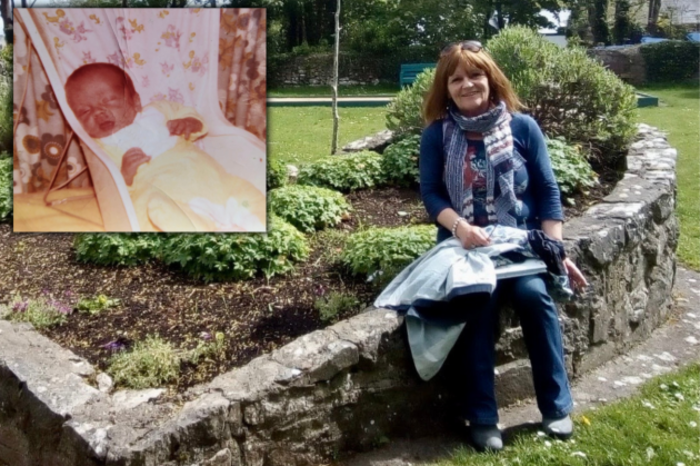 Terri Harrison has just one photo of her baby Niall - inset - born in a mother and children institution
Terri Harrison has just one photo of her baby Niall - inset - born in a mother and children institution

Almost €40m from four Dublin properties
The Daughters of Charity of St Vincent de Paul ran St Patrick’s on the Navan Road – also known as Pelletstown – in Dublin and are one of the congregations in negotiations with Minister O’Gorman regarding redress for survivors of mother and baby institutions.
St Patrick’s was not exclusively a mother and baby institution, as it also housed unaccompanied children. Over 3,600 children died there mainly between 1920 and 1942.
A spokesperson for the order told Noteworthy that it “did not own” or were “trustees of any Mother and Baby Home facility and neither were we involved with adoptions”. The spokesperson said it has “made a full and total contribution to the state, entirely in keeping with our commitment to redress”.
It has been reported a number of times that the Daughters of Charity were associated with adoptions. For instance, in 2015 a woman sued the congregation alongside the HSE and another order over the alleged forced adoption in the late 1960s of her four-month-old baby.
The case was ultimately dismissed due to being “commenced out of time”, but the president of the then High Court – Mr Justice Nicholas Kearns – wrote that he was “satisfied” that the congregation “was an active participant in this highly questionable process”.
The property and land assets belonging to the Daughters of Charity was estimated to be worth €286.4m by the 2009 report of the panel appointed to assess the statements of resources submitted by religious congregations as part of the Ryan Report. At that time, the congregation had 215 members in Ireland, over 60% of which were aged 70 or older.
Our investigation found that the Daughters of Charity sold the highest value of properties of congregations analysed by Noteworthy.
Four south Dublin properties made almost €40m between them since 2016, including the sale of a site on Temple Road Blackrock in 2017 for €30m to developer Paddy McKillen jnr’s Oakmount, as reported by the Independent at the time. It was subsequently reported by The Irish Times that the site was put up for sale for €45m three years later.
 View of one of the buildings on the Temple Road site in May 2021
View of one of the buildings on the Temple Road site in May 2021
Another property at Newtownpark Avenue was for sale with a guide price of €6m in 2019, as reported in The Irish Times, though the final sale value was not publicly available.
Two further south Dublin properties were sold in recent years including Seton House in Ranelagh for almost €2m in 2021 and St Teresa’s House in Blackrock for €1.2m in 2017.
The congregation did not verify the sale of any properties that the investigation team queried with them.
Seton House was listed as the congregation’s address on a number of sources in recent years – including by the Minister for Education in answer to a parliamentary question in 2017. However, as with many properties in the Land Registry, the previous owners are not listed in its folio.
A section on the sale of St Teresa’s House was featured in the congregation’s newsletter last year which stated the keys of St Teresa’s were handed over to Oakmount Developers in December 2020 following its sale in 2017. The newsletter mentions an agreement following the sale that “the Sisters could continue to live in the house for up to five years”.
When asked what the congregation did with the revenue generated from these sales, a spokesperson said that “the sale of property (fully owned by the congregation), is done primarily as the property is no longer required to support our various services”.
They said that the organisation’s “accounts are audited by professionals”, submitted to the Charities Regulator and that it is fully compliant “in this regard”. They added:
“The sale of property is a means of supporting our various services in this country and making provision for the support of a significant number of retired and elderly sisters. The Irish Province also provides ongoing support to mission work in Kenya.”
The order has paid €6m in redress during this time – which completed the money owed as part of their voluntary offer for institutional child abuse. However, in regards to the involvement of the Daughters of Charity in mother and baby institutions, the spokesperson stated:
When we made our contribution to Redress we also advised the authorities that it included a contribution to the historic services on the Navan Road, including the Mother and Baby Home, should this be required.
Harrison said that this was “a very minor contribution” as part of the Ryan Report to those who gave birth up to the age of 18 but anybody older “didn’t get a penny”. She wants the congregation to compensate survivors for wages owed, the cost of medical and therapeutic care as well as “the negligence that they charged” the State and taxpayers for their care.

Nearly €8m from sale of former institutions
Alongside thousands of other women, Harrison was also “an inmate” – the term she prefers to describe her time there – of Bessborough mother and baby institution in Co Cork. It was operated by the Sisters of the Sacred Heart who bought the Georgian house on 150 acres with financial assistance from the Archbishop of Westminster.
An estimated 6,000 births were registered there between 1929 and 1987, with a mortality rate as high as 50% for extended periods and more than 900 children dying at or in hospital after being transferred from the institution.
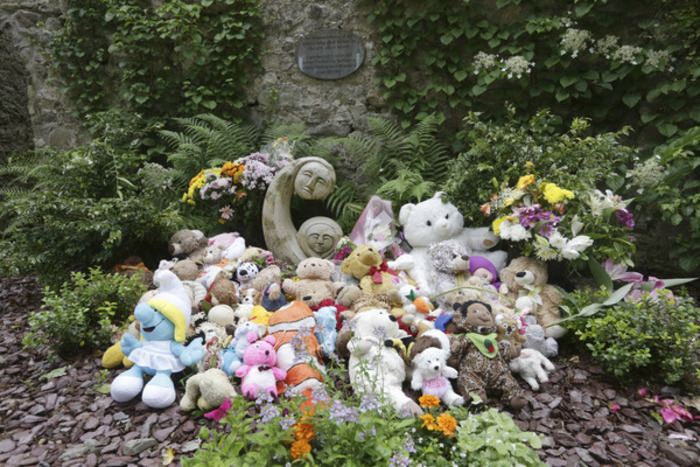 Children’s toys and flowers at the 'Little Angels' memorial plot in the grounds of Bessborough House in 2014
Children’s toys and flowers at the 'Little Angels' memorial plot in the grounds of Bessborough House in 2014
The Sisters of the Sacred Heart weren’t included in the Ryan Report but their latest financial accounts lists 23 properties located in Tipperary and Offaly that are held in trust for the congregation.
Noteworthy asked the congregation for the value and purpose of these properties. A spokesperson said that it is “fully compliant with the statutory authorities… in all respects in regard to submissions on our assets, including property in Ireland”.
The nuns were accused of a “run and grab all attempt” by staff when they put it up for sale in 2019. The following year, the estate was sold for €6.85m. It was reported by The Journal at the time that over the twenty years preceding the sale, €30 million in State funding was spent on Bessborough to maintain and upgrade the site.
Controversy ensued with the refusal – after a campaign by survivors – of planning permission for controversial apartments which overlapped an area of land marked on historic maps as a “children’s burial ground”.
Around that time, the congregation also sold parts of Sean Ross Abbey in Co Tipperary – the site of another mother and baby institution which was closed in 1969 and where over 1,000 babies died that were either born or admitted there. It has a guide price of €1.25m, according to the Irish Examiner, when put on the market in 2018.
Four of the properties at Sean Ross Abbey were listed in the property price register, earning a total of €600,000 between them. However, the order’s 2019 accounts list the “net proceeds” of the sale of Sean Ross Abbey and a house in Corville Road as almost €1m.
The order’s accounts also state that they “are giving the remaining assets at Sean Ross Abbey” to the local Diocesan Trust for a cost of €1.
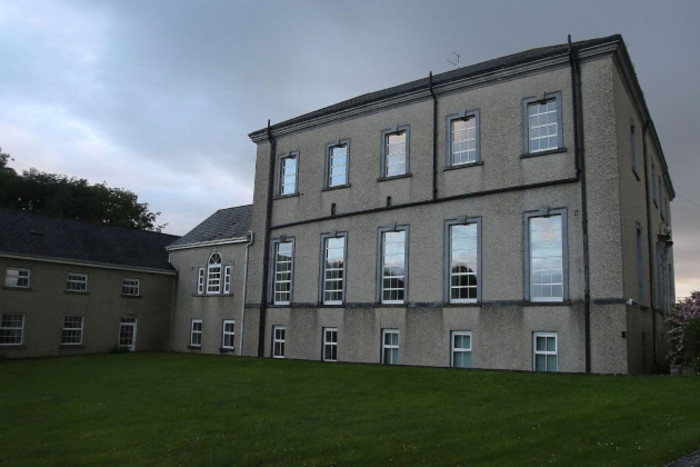 Sean Ross Abbey in Roscrea Co Tipperary was sold by the Sisters of the Sacred Heart in 2019
Sean Ross Abbey in Roscrea Co Tipperary was sold by the Sisters of the Sacred Heart in 2019
When asked what the proceeds of these sales were spent on, a spokesperson said: “Our assets available to us in Ireland are used to support a group of over twenty retired sisters, who dedicated their lives to various services in Ireland.”
They said that they “are also used to provide some support” to international mission work and “until recently” providing “support to the present day Bessborough Centre”.
According to the spokesperson, the congregation was “requested and invited by Irish authorities” to establish the “homes” in Ireland, that they purchased the properties from their “own resources” and “at various times” funded developments “as funding from Irish authorities was insufficient”. They added:
Our sisters worked for at least four decades in the Mother and Baby Homes in Ireland without a salary from the Irish Authorities.
Some nuns who worked in mother and baby institutions owned and controlled by local authorities were paid a salary – including the Daughters of Charity who ran St Patrick’s in Dublin – but Bessborough was a private institution and its governance was a matter for the Sisters of the Sacred Heart, according to the Final Report of the Commission of Investigation into Mother and Baby Homes.
When the statement by the Sisters was put to Harrison, she said that Irish authorities were “paying per head”. She added that the nuns “lived like ladies” and “had everything at their fingertips”. “We fed them, cooked their meals and did their laundry.”
They gave us life sentences. Our unborn babies were commodities.
Harrison also mentioned another source of revenue – “donations that went in from an elated people who couldn’t have children of their own” as part of the adoption process.

Scale of property and land ownership
The Sisters of Mercy also ran a mother and baby institution – the Clare County Nursery in Kilrush, where though the numbers that died is not known, the “medical officer described the death rate in 1927 as appalling”, according to the Commission of Investigation. In addition, the congregation was involved in Magdalene laundries and institutional child abuse.
Its ownership of properties is on a scale far above any other congregation that Noteworthy analysed. In 2009, the assessment done as part of the Ryan Report revealed over €1bn worth of land and building assets.
We found that this congregation – or its subsidiaries – likely disposed of over 45 properties worth a total of over €15m in recent years. This does not include 16 additional properties sold by the order whose €5.9m proceeds were then transferred to the State for redress. The State received just over €1m in cash from the congregation since 2016.
Many of these properties were former Convents of Mercy – with a large number sold along the West coast of Ireland including in Co Cork, Limerick, Clare, Galway and Mayo.
The Noteworthy team sent a number of queries to the congregation regarding these property sales, including what was done with the revenues generated, but a spokesperson gave the investigation team an update on redress and said that it was “not appropriate to comment on the unrelated issues raised”.
We attempted to verify all sales but not all had the previous owners listed on Land Registry folios – a common issue. In addition, not all properties were registered with the Land Registry and for these, no folios were available.
Many of the properties appeared in various company accounts associated with the congregation or were verified through newspaper articles and other publicly available information that associated the congregation with the property.
More sales than this may have taken place since 2016 but difficulty in verification and a lack of publicly available information about land sales limited the team’s scope.
Over the 20-year period from 2000 to 2020, the congregation also received a payment of £22m Irish pounds (€27.9m) for the handing over of the Mater Private Hospital in Dublin – not included in our calculations above. It was reported by the Independent at the time that the greater part of this income would be directed to the public hospital for services not funded by the State.
Through a search of the Land Registry, we did discover that despite these sales, various trusts associated with the congregation still own over 70 plots of land and over 170 properties around Ireland. These companies include the Sisters of Mercy Trust as well as the South Central, Western and Southern Provinces.
One of the largest sales since 2016 was Balloonagh Convent which was handed by the nuns to the Diocese of Kerry who then sold it for €800,000 last year. Its contents were also sold for over €100,000 back in 2015, according to local news site, Tralee Today.
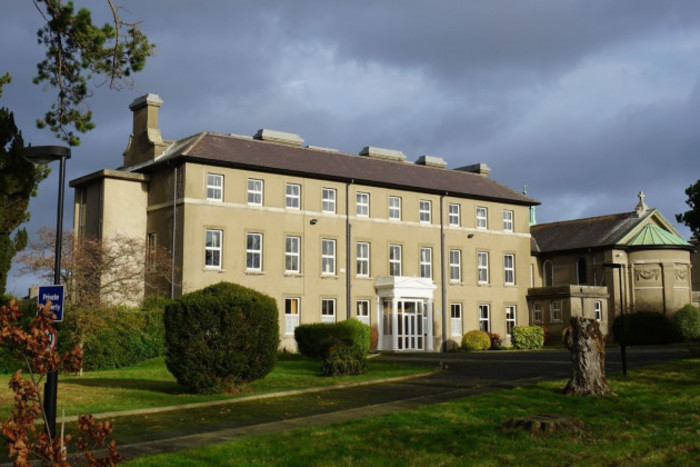 Beaumont Convent was sold to the HSE for over €2.7m last year
Beaumont Convent was sold to the HSE for over €2.7m last year
The congregation gained the most from the sale of a convent beside Beaumont Hospital in Dublin which we reported as being sold to the HSE for over €2.7m last year.
This convent adjoins Beaumont Convalescent Home which includes Beaumont House; Rockfield and St Anne’s which was transferred to the HSE by the nuns in 2017 as part of redress at a value of €1.9m.
According to a HSE spokesperson, Beaumont House was vacated by the Sisters of Mercy in 2013. Between then and the transfer to the HSE, “the property was unoccupied, with no power or heating”. In 2016, the “HSE undertook protective and security measures” to the property “to prevent further deterioration while the transfer was underway”.
To date, the HSE has spent around €250,000 “on the preparation of plans, minor maintenance and security works to the buildings”. The spokesperson said it was too early to confirm the “overall anticipated costs of the works”.
The HSE and Beaumont Hospital are “planning the relocation of non-core hospital functions”, thereby facilitating “important future developments to support clinical service delivery”. The HSE spokesperson said that a design team is progressing “is working towards submitting a planning permission application this year”.
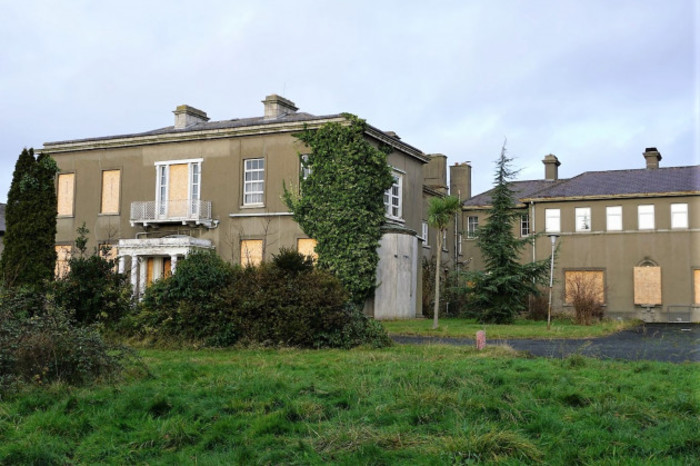 Beaumont House was left vacant from 2013 to 2017 before being transferred to the HSE as part of redress
Beaumont House was left vacant from 2013 to 2017 before being transferred to the HSE as part of redress
Shortfall in redress offered
The redress contributions agreed by the Sisters of Mercy as part of both the 2002 Indemnity Agreement and 2009 voluntary offers were significantly higher than other congregations.
According to the congregation’s spokesperson, it has “contributed” property and cash “in excess of €33m” as part of the Indemnity Agreement. It has one outstanding property in the process of transfer in Mouthawke in Tralee Co Kerry valued at €2.7m.
This was significantly delayed due to “litigation over the boundary of the site which involved a third party” which a DoE spokesperson said has “now been resolved”. They added that “it is hoped that this transfer will be finalised shortly”.
Figures provided by the Department of Education show that the nuns have transferred properties worth just over €21m to date as part of the Indemnity Agreement but the cash figure was not broken down.
A total of €65m was paid in cash and counselling contributions by all congregations for this agreement but it is not possible to identify the amounts paid by each congregation as payments were made collectively.
In total, the Department of Education told Noteworthy that the “total cost of the State’s response to the abuse which took place in industrial schools, reformatories and related institutions, will amount to approximately €1.5 billion”.
We analysed redress paid through the 2002 Indemnity Agreement and 2009 Voluntary Offers and found that just 70% of the total value of redress offered – €247m out of €353.6m – has been paid to date, with over 90% of this shortfall – €97.7m – from the Sisters of Mercy.
A property not included in these figures is a childcare facility that was transferred last month by Our Lady of Charity of the Good Shepherd as the valuation is still pending. This property was valued at €1.5m in 2009 and if that value still holds, it brings the total redress paid to €248.5m between the two schemes.
Factors such as possible changes in the valuation of the properties offered as well as those that were offered but not accepted as contribution to redress will most likely account for a large proportion of the rest of this shortfall.
“The total value of the voluntary offers will not be known until all transactions have concluded,” according to the DoE spokesperson.
The Sisters of Mercy made an offer that was valued at €127.5m in 2009. This included a mixture of cash, property transfers to State bodies and the voluntary sector as well as property sales whose proceeds being transferred to the State.
The full cash amount (€20m) – with interest – has been transferred and there is one outstanding property transfer and another property to be sold as part of this offer.
However, to date, with all but one property – the National Rehabilitation Hospital in Dublin – to be transferred, the value of the 15 properties transferred amounts to €6.6m, according to figures provided by the DoE. Another €14.9m worth of properties was transferred to the community and voluntary sector but not reckoned by the Government as a contribution towards the cost of redress.
As well as this, the nuns sold 16 properties from March 2013 to date with €5.9m worth of proceeds received by the State. There is one property in Cahir Co Tipperary – valued in 2009 along with an adjoining site at €1.6m – still to be sold.
A source told Noteworthy that a large proportion of this shortfall will be made up with the transfer of the National Rehabilitation Hospital to the HSE.
We asked the Sisters of Mercy, Department of Education and the HSE for the value of the property but none supplied it, with a spokesperson for the HSE stating that “this information is subject to legal processes”.
When asked what is causing the delay, the HSE spokesperson said that “the transfer is at an advanced stage with the legal advisors of the Sisters of Mercy”.
A spokesperson for the nuns said that “the Congregation is continuing to do all in its power to complete the two outstanding property transactions”.

Sales to builder and Co Kildare hotel
When it comes to property sales since 2016, the Christian Brothers were next on the list with almost €20m from a number of sales, €18m of which from the controversial sale of land beside Clonkeen College in Co Dublin to pay for redress.
This was reported in The Irish Times as being sold to builder Patrick Durkan Snr after the settlement of a High Court case with the school’s board of management when the amount of land given to the school was increased.
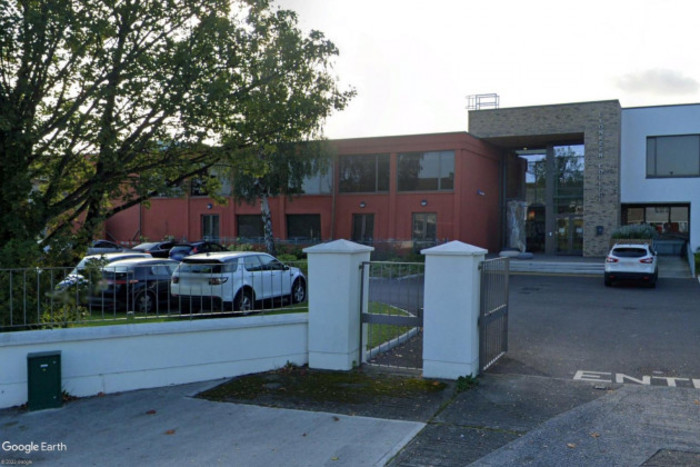 Clonkeen College where land was sold by the Christian Brothers to pay for redress
Clonkeen College where land was sold by the Christian Brothers to pay for redress
Another property – Christian Brothers House – in Naas Co Kildare was sold to the owners of neighbouring Lawlor’s Hotel for €900,000 last year, as reported by Kildare Now.
The congregation sold Monastery House in Carrick-on-Suir Co Tipperary for €245,000 in 2018. A property in Kells Co Meath – marked as sold online – had no publicly available sale price and the folio on Land Registry is still under the Christian Brothers. An auction of the contents of this house was advertised in 2019.
When asked about these sales, a spokesperson said that “from time to time the Congregation may sell properties for any number of reasons – sometimes at a heavy discount e.g. to a local community or charity to facilitate their work or, on other occasions because a property is no longer required, or simply to help bridge an operating deficit. It does not comment on individual sales.”
They added that one property is accommodating “almost 100 displaced Ukrainians at no financial gain to the Congregation”.
According to the spokesperson, “net assets include restricted assets” such as those “fully or substantially committed” to areas such as education, e.g. Marino Institute, and social housing “as well as investment assets” which are used to finance – among other things – “the future care needs of the Congregation’s aging population”.
The Ryan Report found that molestation and rape were “endemic” in boys institutions, chiefly run by the Christian Brothers. The Department told Noteworthy that “the congregation offered cash amounting to €30m, and this contribution was completed in 2019”. Since 2016, the order has paid €20m (cash) in redress.
The initial 2009 offer by the Christian Brothers was €34m included €4m in counselling services “which the Government decided not to reckon as a contribution”, according to a DoE spokesperson.
A spokesperson for the order told Noteworthy that €11m in counselling and therapeutic services was provided by the congregation.
However, the Christian Brothers had originally offered to set up a joint trust between the Edmund Rice Schools Trust and the Government for 49 school playing fields and associated lands which were valued at €127 million in 2009. The Edmund Rice Schools Trust was established by the congregation in 2008, with no State involvement in its ownership and management, according to the DoE.
This offer was subsequently withdrawn by the congregation, according to the 2016 Comptroller and Auditor General report, and instead the order is in the process of transferring these solely to the Edmund Rice Schools Trust.
The DoE spokesperson told Noteworthy that the congregation offered “a mechanism under which the State would receive 50% of the proceeds of the disposal of 49 specified playing fields” and it is “the Department’s understanding that, to date, none of the 49 playing fields have been disposed of”.
In a submission to the Dublin City Council development plan last February, the congregation urged planners to rezone land that playing fields are on – currently zoned as Z15 – ‘Community and Social Infrastructure’.
Their submission stated that “proposed key policy changes” to this zoning category were “of significant concern”, including that “residential use is no longer open for consideration” except for “highly exceptional circumstances”. It added that these changes imposed restrictions “on delivering residential development and surplus and underutilised” lands.

‘Uninterrupted views over Dublin Bay’
Two other religious organisations made submissions to Dublin City Council as part of this consultation – the Handmaids of the Sacred Heart of Jesus based in Stillorgan and the Religious Sisters of Charity in relation to their 6.55-hectare campus at Merrion in Dublin 4.
Both asked for reviews of the proposed Z15 zoning, with the Sisters of Charity stating that it “creates a barrier to other future essential and appropriate uses, including housing”.
The Irish Times reported at the time that if housing was allowed on their land, its value would increase to €50m.
This congregation were also owners of St Vincent’s University Hospital which was transferred to a new holding group in recent years. They sold a large amount of land over the past few decades including 14 acres near the hospital for €46m in 2001. In 2009, the congregation’s land and building assets were valued at €233m.
We examined sales of properties associated with the congregation since 2016, with over €5m in sales recorded. This includes a former convent at Gardiner House in Dublin – now a hostel – which was sold for €1.65m in 2016.
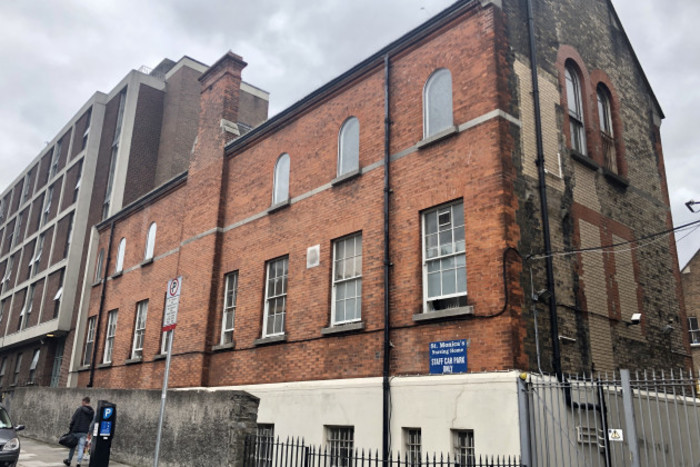 Much of this former nursing home appears to be in use, with signs in Ukrainian taped on the main door
Much of this former nursing home appears to be in use, with signs in Ukrainian taped on the main door
The 3rd Floor of St Monica’s Nursing Home in Dublin was also sold at the start of this year for €1.55m, according to the property price register. This nursing home near Mountjoy Square was closed by the Sisters in 2020.
The last accounts submitted by St Monica’s Nursing Home Ltd before its liquidation, stated that two nominees of the nuns were its “ultimate controlling parties” and the property was “leased from the landlords, the Religious Sisters of Charity”.
The congregation was not “able to comment” on any of our queries, according to a spokesperson. However, a HIQA inspection from 2016 stated that the nursing home – at the time – consisted of 45 bedrooms over four floors of a six-story building, with the top two floors in private use.
A widely reported sale by the congregation was that of Stella Maris in Howth Co Dublin with “completely uninterrupted views over Dublin Bay”, comprising buildings of almost 900 square metres and listed as a “retreat house” and “leisure property” by the estate agents during its sale. The property sold for €1.95m at the end of 2019.
On their website, the Religious Sisters of Charity wrote that the sale was “to support the charitable work the Congregation does in Ireland and its missionary work abroad”. Sr Mary Christian, Superior General said:
“Due to the inability of our ageing Congregation to continue our retreat work, a decline in numbers attending and the need to spend a great deal of money to modernise what is a Victorian 19th century building, we have decided to sell.”
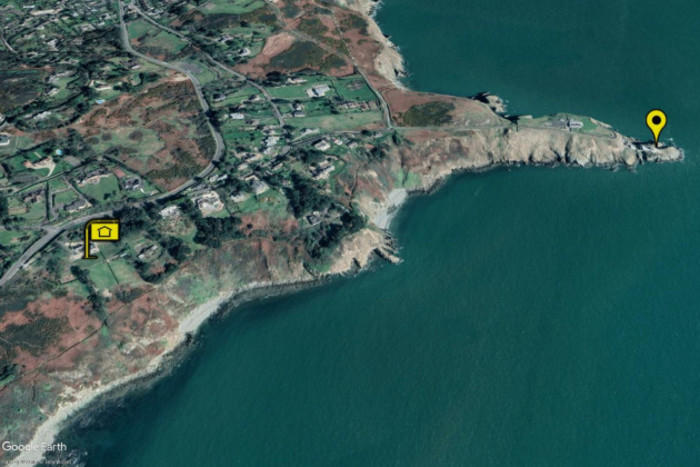 Stella Maris (left marker) is located near Baily lighthouse (right marker) in Howth
Stella Maris (left marker) is located near Baily lighthouse (right marker) in Howth
The congregation have no redress payments outstanding with their redress contribution comprising of €2m in cash and €3m in waived legal costs from the Commission to Inquire into Child Abuse. The nuns also transferred €11.8m worth of properties as part of the Indemnity Agreement.
The Sisters were one of the four congregations who the Government reported “following reflection on the matter” – on making a contribution to the cost of the Magdalene laundries scheme – “declined to make a financial contribution”.
They also took over the running of the adoption agency St Patrick’s Guild in 1943. State agency Tusla established that at least 126 births were illegally registered between 1946 and 1969, with a once-off payment for those impacted set up by the Government earlier this year.
The Journal reported that Kathleen Funchion, Sinn Féin’s Spokesperson on Children, said this once-off payment to a selection of the people affected is “an insult”.

Nursing home developed despite local opposition
Another group of nuns involved in institutional child abuse that have parted with property in recent years is the Presentation Sisters. A number of convents and land – worth over €5m – have been sold around the country since 2016.
This includes the sale of land north of Scoil Mhuire in Clane Co Kildare – with planning for houses, apartments and a creche. The Irish Times reported that the land was on sale for more than €3m in 2018, with the final price not publicly available.
Abbott Field, “a high-class development” of two, three and four bedroom homes – according to the estate’s website – was developed by Westin Homes. The secondary school and its pitches are visible from many of the – now occupied – houses.
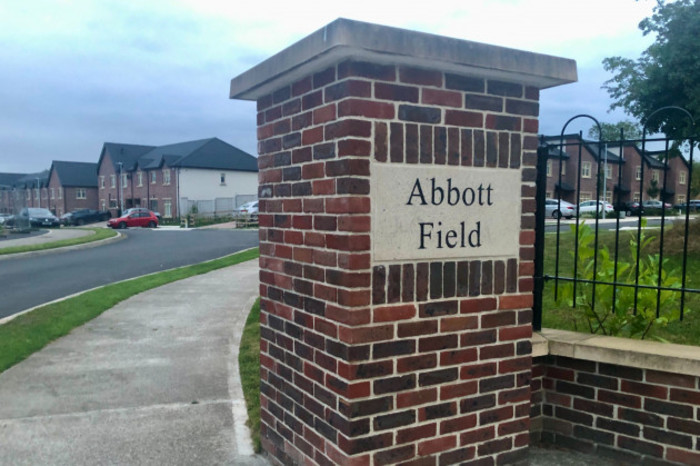 Abbott Field in Clane was developed on land sold by the Presentation Sisters
Abbott Field in Clane was developed on land sold by the Presentation Sisters
The other sales consist of convents, mainly in the south of the country, including ones in Ballinskelligs Co Kerry for €775,000 in 2017.
A holiday home owned by the nuns in Wexford – currently listed as sale agreed – was recently put on the market for €700,000.
The Wexford People reported earlier this year that the Presentation Sisters bought the property in 1946 and used it for many years as a holiday home for the nuns who lived at that time in an enclosed order. However, it was now surplus to requirements.
Not included in our sale figures is a contentious property in Clondalkin Co Dublin – sold to developers Bartra which is ultimately controlled by Richard Barrett – for an undisclosed sum in recent years.
The €30m development – still under construction – consists of a 146-bed nursing home, together with 14 single occupancy assisted living homes, according to Bartra’s website.
The investigation team asked the nuns for details on the sale, including the final price, but a spokesperson did not answer this query or any in relation to property sales by the congregation. They said that the Presentation Sisters “are fully compliant with present legislation regarding our accounts, including the sale of property” and added:
“Our accounts are submitted to the statutory authorities annually, having been audited by professionals. We deal directly with the statutory authorities on all related matters.
“Our resources are used to support our various ministries in Ireland and our mission work overseas where our Sisters continue to work with the most marginalised people, in the footsteps of our founder, Nano Nagle”
The spokesperson also said that the congregation has “an ongoing duty of care” to retired and older Sisters.
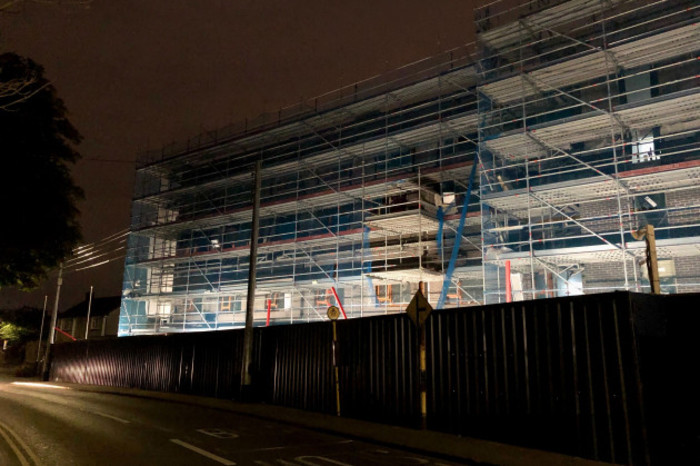 Construction of the nursing home underway - as of last Thursday
Construction of the nursing home underway - as of last Thursday
Despite significant opposition from residents, community groups and politicians the Clondalkin nursing home plans were upheld by An Bord Pleanála.
When there was confirmation that Bartra could commence the work, locals – who questioned how the Presentation Sisters became the sole owners of the land – were disappointed that their campaign to protect the historic site in the village was unsuccessful, according to Echo.ie – a local news site.
In a statutory declaration submitted as part of the planning process, the nuns stated that “the sale to Bartra is to facilitate the construction of a nursing home to include assisted living accommodation to enable a number of Presentation Sisters to continue to live on part of the Property and continue to provide services to the local community in Clondalkin”.
It added that “the majority of the remaining Sisters are elderly and the present convent is not suited to their needs” and stated the congregation had “no other property available for this purpose in the Dublin area”.
The Presentation Sisters had land and building assets worth €394m in 2009. From a search of the Land Registry, Noteworthy found that the Presentation Sisters Property Trust is listed as owning 18 properties, plans and plots of ground, including five in Dublin. This includes two properties in Lucan and one in Adamstown.
According to the spokesperson for the Presentation Sisters, their contribution to redress “is fully paid”.
Figures provided by the DoE show that they transferred €5.25 worth of properties as part of the Indemnity Agreement, €4m in cash and €740,000 in property as part of the 2009 offers. However, the value of their 2009 offer was €5m.
The €260,000 shortfall is most likely due to a change in valuation of the property – St Bernard’s Group Home in Co Tipperary – between 2009 and its transfer to the HSE.

The Presentation Sisters are not the only congregation to sell their land for the development of a nursing home. Lands and buildings at the former Saint John of God Secondary School in Artane, Dublin, were sold by the Sisters of St John of God.
Though a different company originally applied for planning permission in 2016, the ultimate developer was Bartra who – according to the Independent – acquired the site in 2017. Though it was put for sale in 2008 with a price tag of €3.5m, the Sisters of St John of God were listed as owners on the 2016 planning documents.
Bartra Healthcare state on their website that the resulting 221 room €45m Beaumont Lodge opened in 2020.
When asked how much the site was sold for as well as a number of other queries, a spokesperson for the Sisters of St John of God told Noteworthy that “the Congregation may sell properties for a number of reasons, where the property is no longer needed, or to contribute to bridging an operational deficit. We do not comment on individual sales”.
They added that they have previously “disposed of a number of assets” for “less than market value” to State-funded organisations as well as charities in the care sector. They also mentioned they are allowing the use of their Kilkenny convent to house “around 100 Ukrainian refugees” at no charge.
“At this stage, our resources are such that we are spending considerably more each year than our income, so we are eating into our resources. Planned asset sales are used to bridge the gap.”
The congregation is currently in talks with Minister O’Gorman due to their running of Thomastown County Home – a mother and children institution in Co Kilkenny. Over 170 “illegitimate” children died in infancy or early childhood there, with over 50% of mothers experiencing the death of at least one child, according to the Commission of Investigation.
On this, the spokesperson for the Sisters of St John of God said: “We met with Minister O’Gorman in December 2021. He asked that the contents of that meeting be kept confidential for now and we respect that.”

Millions paid to congregations in rent
The investigation team examined three final congregations. The Hospitaller Order of St John of God had the second highest land and building assets in 2009 – over €470m worth.
Noteworthy found that the Saint John of God Housing Association is still on the Land Registry as owning 40 properties, plans or plots of land – with 35 of these located in Dublin and surrounding counties.
A spokesperson for order told Noteworthy that the €470m value “used in the Ryan report was the cost of reinstatement” [to completely rebuild if destroyed] but the value based on cost “as stated in the audited financial statements of the relevant companies is €150m”. These properties are used for the provision of intellectual disability, mental health and education services.
The order’s contribution to redress is fully paid with €590,000 in property transferred as part of the Indemnity Agreement and €1m in cash given as part of the 2009 voluntary offers.
According to a spokesperson for the order, it has not sold any properties since 2016. They added that its latest sale was a property at Parnell Road in Dublin which sold for €2.25m in 2015. “There have been no further sales.”
This was sold as “the building was no longer fit for purpose”. The spokesperson said that “the proceeds of property sales are applied to funding the services of the Order” and added:
“The Order over the period 2013 to 2019 provided €17.3 m emergency funding to support St John of God Community services, which had built up an accumulated deficit of €31 million over that period due to insufficient levels of HSE funding to support the services and supports being provided to children, adolescents, and adults in accordance with the requirements of legislation regulation and national policy.”
Last year, local paper The Kerryman reported a warning by the order that St Mary of the Angels Beaufort – which provides disability services in Co Kerry – could be sold to pay off this debt.
When asked for an update on this, the order’s spokesperson told Noteworthy that “this matter is now being addressed through a sustainability impact assessment process that is ongoing with the HSE. There are currently no plans to sell property to pay off the debt.”
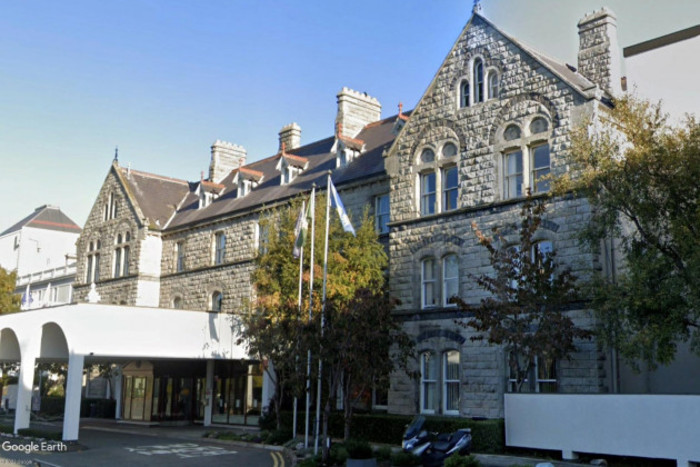 Saint John of God Hospital in Stillorgan
Saint John of God Hospital in Stillorgan
Noteworthy also asked the order – as well as other congregations if any properties generate rental revenue. St John of God was the only order to respond to this query. A spokesperson said:
“Rental properties owned by the Trust are St John of God Hospital and a neighbouring residential facility in Stillorgan, Drumcar Farm in Louth, a charity shop and car park in Co Kildare, all of which generate circa €1.9m in revenue annually… Rental income is used largely to fund the Order in Ireland, UK and Malawi.”

We also examined property sales by Our Lady of Charity of the Good Shepherd, a congregation created from the merger in 2014 of the Good Shepherd Sisters – who were involved in institutional child abuse, Magdalene laundries as well as mother and baby institutions – and the Sisters of Our Lady of Charity – who were involved in institutional child abuse and Magdalene laundries.
The Good Shepherd Sisters did not offer any redress as part of the 2009 voluntary offers, according to the Comptroller and Auditor General report. The redress commitment made by the Sisters of Our Lady of Charity “has been fully honoured”, according to a spokesperson for the order, completed with the recent transfer of Blaithín childcare facility in Drumcondra, Dublin.
“On all matters relating to Redress we deal directly with the Department of Education and on all matters relating to Mother and Baby Homes we deal directly with the Department for Children. We communicate directly with them on any matters they may wish to discuss with us.”
We found a recent seven-bed property in Goatstown, Dublin, which was sold earlier this year for almost €1m. The property did not have a folio on the Land Registry but its address was also used by the congregation in a letter to the Taoiseach a number of years ago.
A small oratory with a stained glass window and the Stations of the Cross is included in the online brochure, with religious statues and images also in a number of rooms, including one of Sister Mary Euphrasia Pelletier – the founder of the congregation.
The congregation did not confirm the sale of this property, but a spokesperson said that they “sell property, which is longer suitable or necessary” for their needs. They added: “Our assets are used to support our various ministries and to provide for a community of mostly retired sisters.”
The Sisters of Our Lady of Charity made a number of lucrative property sales over the past few decades, including a €61.8m deal for the Magdalene laundry site at High Park, Drumcondra, according to the Irish Examiner.
Remains of 155 women who were buried over the previous 100 years were discovered at a plot of land in the same High Park campus in the early 1990s, with the deaths of many not registered with authorities. The Irish Times reported a number of years later that all but one were subsequently cremated at Glasnevin Cemetery.

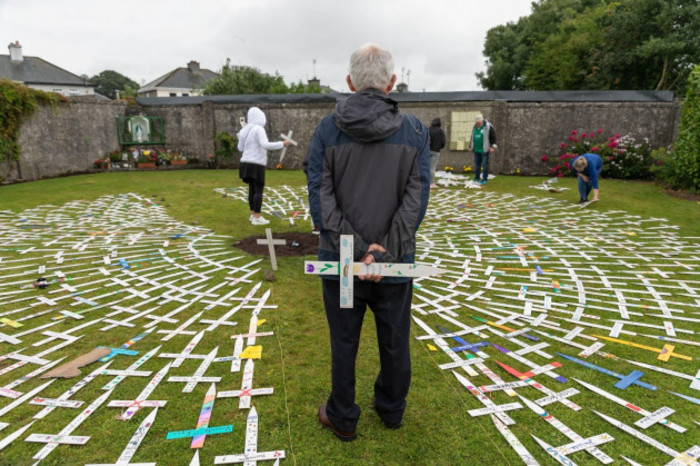 An event last year where the names of the babies and children who died at Tuam were written on crosses
An event last year where the names of the babies and children who died at Tuam were written on crosses
The final congregation Noteworthy examined was the Sisters of Bon Secours – also involved in talks regarding redress for mother and baby institution survivors with Minister O’Gorman – due to their running of Tuam “Children’s Home” from 1925 to 1961.
Almost 980 children died there, according to the Commission of Investigation, with the remains of hundreds of young children and babies found in a chamber of a disused septic tank in 2017.
The congregation offered €2.5 million for the cost of the forensic excavation of the site – due to start “as soon as possible”, according to Minister O’Gorman, once a director of an independent office being set up to lead it is appointed “in the Autumn”. Its cost was estimated between €6m and €13m in 2018, with some speculating at the time that it could cost significantly more than that.
We examined properties in the Land Registry owned by companies associated with the Sisters of Bon Secours.
10 properties split between Cork, Glasnevin in Dublin and Tralee in Cork are registered to the Bon Secours Trustees company as well as one plot of ground in Tralee.
Bon Secours Health System has another six properties and four plots of ground – with most properties located in Glasnevin in Dublin and Renmore in Galway, locations of Bon Secours Hospitals. Almost four hectares is split between three of these plots of ground in Galway.
According to the latest company accounts, the private hospital group paid €4.3m in both 2019 and 2020 to Bon Secours Trustees Unlimited Company “in respect of the leasing of buildings”. This company “acts as a trustee whereby it holds properties in trust on behalf of Sisters of Bon Secours Ireland”.
A spokesperson for the Sisters said that they “have stated publicly and to the Minister for Children that it is their intention to participate in the Mother & Baby Home Redress Scheme when it is established”.
The congregation did not respond to our queries on the value of their property portfolio, the revenue generated from it or if any sales took place in recent years.
—
Redress talks just ‘tea and biscuits’
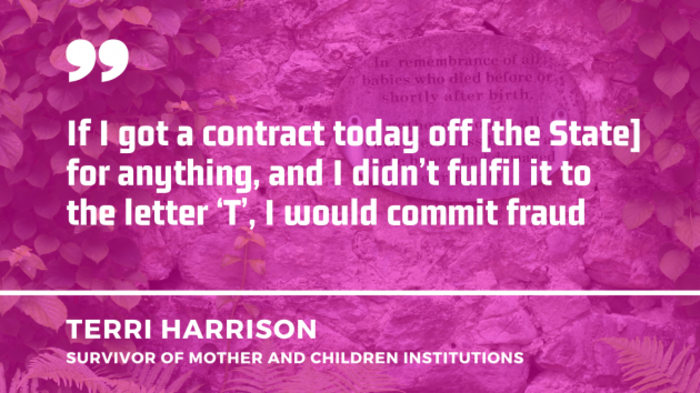
Following the publication of the Commission’s report on mother and baby institutions last year, Taoiseach Micheál Martin said that “the religious orders concerned in particular should make a financial contribution to any scheme that the Government will be developing, particularly where lands would have been sold, for example,” as reported by the Independent.
With the cost of redress of abuses involving religious organisations adding up for the Government, survivor Terri Harrison told Noteworthy that she felt the Government is not strong on getting funding for redress from congregations because the whole system “was a farce”, with the State knowing it also “failed”.
“If I got a contract today off [the State] for anything, and I didn’t fulfil it to the letter ‘T’, I would commit fraud,” she added, on the lack of care she received by the nuns in mother and baby institutions.
“Roderic O’Gorman has told me time and time again that he’s having conversations.” She is concerned that the ongoing redress talks are just “tea and biscuits” that won’t amount to anything.
We sent our findings to the Department of Education and asked the Minister for Education Roderic O’Gorman if religious congregations should contribute a proportion or all of the revenue generated to the State for redress going forward.
A spokesperson for the DoE said that the Minister “is currently engaged in discussions with each of the congregations involved with Mother and Baby and County Home institutions and, in that context, it would not be appropriate to comment on any potential additional contributions by the congregations towards the costs of redress”.
—
Have a listen to The Explainer x Noteworthy podcast – out now – which delves into the investigation’s findings and explores the work involved to uncover this information.

Our HOLY LAND investigation was carried out by Maria Delaney of Noteworthy as well as business reporter Ian Curran when he was working for The Journal.
It was proposed and funded by readers of Noteworthy – our investigative platform.
Additional resources were required for this project due to the volume of research and analysis needed. If you would like to help towards the cost of this work, please support our general investigative fund HERE>>
You can also help by funding one of our proposed projects or submitting an idea for a story.




